Published date: 24 October 2022
Installing LED lights to save money and reduce carbon emissions
In 2021/22, we saved £2 million and 2,000 tCO2e for the NHS.
Challenge
Our estate currently uses a mix of traditional lighting types and fittings, typically made up from fluorescent strip lights, compact fluorescent downlights, halogen lighting and sodium lamps.
These traditional forms of lighting are poor at converting electrical energy into light and produce heat as a by product of the energy input. This means that only a portion of electrical energy is converted into light. The light output of these technologies can also be poor and cause flickering of the lamp, which could lead to headaches and eyestrain. In addition, the typical fluorescent lighting needs regular maintenance and replacement.
LED technology has reduced in cost and improved in quality over the last few years so proves to be a highly effective and efficient alternative. They can save up to 75% in electricity costs and produce clearer and crisper light levels, which is especially important in healthcare facilities. LED lights have a long lifespan, and should only need replacing every 10 years, reducing our maintenance costs and risk of failures.
Using our Spend-to-Save budget, we decided to replace traditional lighting with LED alternatives to reduce costs and carbon emissions associated with lighting our buildings.
Solution
At the start of 2019/20, we carried out a competitive tender process to select a single supplier to supply and install LED lighting across the estate over a 3-year programme.
The initial phase of works was to install £1.5m worth of LED upgrades across 40 properties in the first year. With similar amounts planned for the next 2 years, up to £4.5m.
Energy Saving Lighting Ltd conducted a number of building surveys. We then selected the sites based on the costs and potential savings, with the properties that meet a potential payback of around 2 years being chosen for upgrades. Our local facilities management teams in the regions were fully briefed on the project and took the lead on delivery with the supplier and our customers.
Impact
Year one results:
The first installations took place in December 2019. Due to the Covid-19 lockdown, the works were halted in early March 2020 with 30 out of the 40 planned properties receiving LED lights, costing just over £1m.
We made sure we purchased the fittings for the other 10 properties and re-started the installations as soon as lockdown restrictions allowed in 2020.
The estimated savings from these installations is about £530,000 per annum.
Year two results:
As lockdown lifted, Energy Saving Lighting Ltd carried out a large number of surveys in the South East and London regions and identified 27 properties meeting the criteria, with an investment of £2.3m. These properties included some large sites, such as the Mary Seacole Wing at Royal South Hants Hospital, St Charles Hospital and Horsham Community Hospital.
As the installations for this first batch in 2020-21 continued, Energy Saving Lighting Ltd carried out further surveys across the South East and other areas of England to identify more properties suitable for LED upgrades. The NHSPS Energy and Environment team then applied for additional capital to invest in these properties and succeeded in securing an £1.7m to upgrade LEDs across a further 12 properties.
Overall, in 2020/21, we invested £4.1m in LED upgrades across 39 properties in the South East, London, Midlands and North West. In doing this, we will save £1.5m per annum for the NHS.
This was made possible, even through the Covid-19 lockdown and restrictions through the dedication and professionalism of the NHS Property Services Facilities and Property Management teams and the proactiveness of Energy Saving Lighting Ltd.
Year three results:
Upgrading lighting systems across the estate to LED continues to be an essential part of our carbon reduction strategy.
In 2021/22, we invested over £9.1m on LEDs. We've installed nearly £4.5m in LED upgrades and purchased £4.7m worth of LED lights for installations in 2022-23.
Thanks to the LED installations in 2021/22, the NHS has saved over £2m and 2,000 tCO2e. This is equivalent to CO2 emissions from 220 million fully charged smartphones. We're hoping to save an extra 1,600tCO2e in 2022/23.






